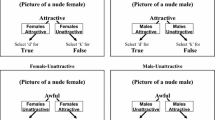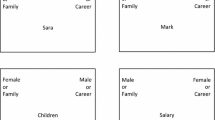Abstract
This study examined the role of gender in both implicit and explicit attitudes toward sexuality. Implicit attitudes are judgments or evaluations of social objects that are automatically activated, often without the individual's conscious awareness of the causation. In contrast, explicit attitudes are judgments or evaluations that are well established in awareness. As described in Oliver and Hyde's (1993) meta-analysis of self-report (explicit) data, women report greater negative attitudes toward sexuality than do men. In the current study, we used the Sexual Opinion Survey (SOS) developed by Fisher, Byrne, White, and Kelley (1988) to index explicit attitudes and the Implicit Association Test (IAT) developed by Greenwald, McGhee, and Schwartz (1998) to index implicit attitudes. Research has demonstrated that the IAT reveals attitudes that participants may be reluctant to express. Independent variables examined were participant gender, social acceptability of sexual words, and order of associated evaluations in the IAT (switching from positive to negative evaluations or the reverse). The IAT data revealed a significant Order × Gender interaction that showed that women had more negative implicit attitudes toward sexuality than did men. There was also a significant Order × Acceptability interaction, indicating that implicit attitudes were more strongly revealed when the sexual words used in the IAT were more socially unacceptable. As expected, on the SOS, women had more negative explicit attitudes toward sexuality. There was no significant correlation between explicit and implicit attitudes. These data suggest that at both automatic (implicit) and controlled (explicit) levels of attitudes, women harbor more negative feelings toward sex than do men.
Similar content being viewed by others
References
Bell, K. (2004). A cognitive look at sexual inhibition: Are the notions of cognitive inhibition and sexual inhibition the same? Unpublished honors thesis, Louisiana State University, Baton Rouge.
Bem, D. J. (2000). Exotic become erotic: On the development of sexual attraction. Archives of Sexual Behavior, 29, 531–548.
Bush, S. I. (2001). Implicit and explicit memory of neutral, negative emotional, and sexual information. Archives of Sexual Behavior, 30, 615–631.
Cubbins, L. A., & Tanfer, K. (2000). The influence of gender on sex: A study of men's and women's self-reported high-risk sex behavior. Archives of Sexual Behavior, 29, 229–257.
de Jong, P. J., van den Hout, M. A., & Rietbroek, H. (2003). Dissociations between implicit and explicit attitudes toward phobic stimuli. Cognition and Emotion, 17, 521–545.
Dekker, J., & Everaerd, W. (1988). Attentional effects on sexual arousal. Psychophysiology, 25, 45–54.
Everaerd, W., Jannsen, E., & Spiering, M. (2003). Priming the sexual system: Implicit versus explicit activation. Journal of Sex Research, 30, 134–145.
Fazio, R. H., & Olson, M. A. (2003). Implicit measures in social cognition research: Their meaning and use. Annual Review of Psychology, 54, 297–327.
Fisher, W. A., Byrne, D., White, L. A., & Kelley, K. (1988). Erotophobia–erotophilia as a dimension of personality. Journal of Sex Research, 25, 123–151.
Geer, J. H., & Bellard, H. S. (1996). Sexual content induced delays in unprimed lexical decisions: Gender and context effects. Archives of Sexual Behavior, 25, 379–395.
Geer, J. H., Judice, S., & Jackson, S. J. (1994). Reading times for erotic material: The pause to reflect. Journal of General Psychology, 121, 345–352.
Geer, J. H., & Manguno, G. M. (1997). Gender differences in cognitive processes in sexuality. Annual Review of Sex Research, 9, 90–124.
Geer, J. H., & Melton, J. S. (1997). Sexual content-induced delay with double-entendre words. Archives of Sexual Behavior, 26, 295–316.
George, W. H. (1995). Men's enjoyment of explicit erotica: Effects of person-specific attitudes and gender-specific norms. Journal of Sex Research, 32, 275–288.
Greenwald, A. G., & Farnham, S. D. (2000). Using the Implicit Association Test to measure self-esteem and self-concept. Journal of Personality and Social Psychology, 79, 1022–1038.
Greenwald, A. G., McGhee, D. E., & Schwartz, J. L. K. (1998). Measuring individual differences in implicit cognition: The Implicit Association Test. Journal of Personality and Social Psychology, 74, 1464–1480.
Grover, V. P., Keel, P. K., & Mitchell, J. P. (2003). Gender differences in implicit weight identity. International Journal of Eating Disorders, 34, 125–135.
Heiman, J. R. (1977). A psychophysiological exploration of sexual arousal patterns in females and males. Psychophysiology, 14, 266–274.
Janssen, E., Vorst, H., Finn, P., & Bancroft, J. (2002). The sexual inhibition (SIS) and sexual excitation (SES) scales: Measuring sexual inhibition and excitation proneness in men. Journal of Sex Research, 39, 114–127.
Jelenec, P., & Steffens, M. C. (2002). Implicit attitudes toward elderly women and men. Current Research in Social Psychology, 7, 275–293.
Jellison, W. A., McConnell, A. R., & Gabriel, S. (2004). Implicit and explicit measures of sexual orientation attitudes: Ingroup preferences and related behaviors and beliefs among gay and straight men. Personality and Social Psychology Bulletin, 30, 629–642.
Kihlstrom, J. F. (1987). The cognitive unconscious. Science, 237, 1445–1452.
Oliver, M. B., & Hyde, J. S. (1993). Gender differences in sexuality: A meta-analysis. Psychological Bulletin, 114, 29–51.
Robinette, L. (2003). Implicit and explicit attitudes toward jealousy. Unpublished honors thesis, Louisiana State University, Baton Rouge.
Rodriguez, C. (2003). The Big Five and sexual attitudes in Spanish students. Social Behavior and Personality, 31, 357–362.
Rudman, L. A. (2004). Sources of implicit attitudes. Current Directions in Psychological Science, 13, 79–82.
Sherman, S. J., Rose, J. S., Koch, K., Presson, C. C., & Chassin, L. (2003). Implicit and explicit attitudes toward cigarette smoking: The effects of context and motivation. Journal of Social and Clinical Psychology, 22, 13–39.
Steffens, M. C. (2003). Implicit Association Test: Separating transsituationally stable and variable components of attitudes toward gay men. Experimental Psychology, 50, 33–48.
Wincze, J. P., Venditti, E., Barlow, D., & Mavissakalian, M. (1980). The effects of a subjective monitoring task in the physiological measure of genital response to erotic stimulation. Archives of Sexual Behavior, 9, 533–545.
Author information
Authors and Affiliations
Corresponding author
Rights and permissions
About this article
Cite this article
Geer, J.H., Robertson, G.G. Implicit Attitudes in Sexuality: Gender Differences. Arch Sex Behav 34, 671–677 (2005). https://doi.org/10.1007/s10508-005-7923-8
Received:
Revised:
Accepted:
Issue Date:
DOI: https://doi.org/10.1007/s10508-005-7923-8




